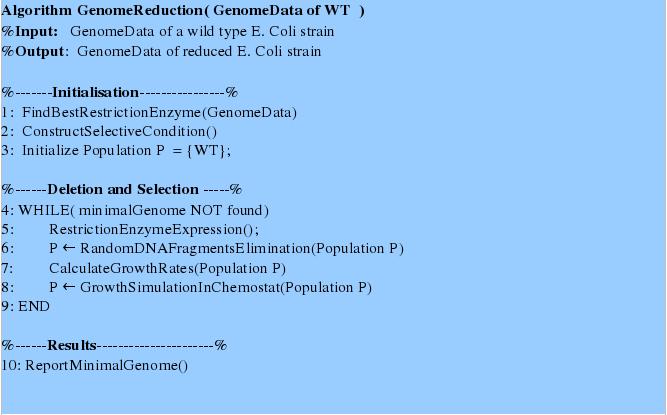|
We propose a novel method of random gene deletion and chemostat-based selection of species with a reduced genome. For this we provide an algorithm described below.
 Genome Reduction Algorithm Modeling Framework
This algorithm requires a modeling framework consisting of four main parts:
- Statistical Analysis of DNA fragments produced by Restriction Enzymes
- Flux Balance Analysis on a Genome Scale Model
- Growth Simulations in Chemostat
- Switch generator for short-time Restriction Enzyme Expression
Detailed description of the Modeling Framework
- Restriction Enzyme Analysis
- We want to identify a restriction enzyme for genome reduction that maximizes the probability of genome reduction and minimizes the probability to hit an (known) essential gene. Therefore, given a genome data of an E. Coli strain, the genome is digested using ca. 700 different restriction enzymes (with different recognition patterns). The resulting fragments are analyzed using the available annotation of the genome. The number of genes disrupted is calculated for each fragment. Statistical measures of the restriction enzyme effects, such as average size of the fragments and its variance, and the average number of (all and only essential) genes and its variance are calculated. According to these results, the most suitable restriction enzyme is chosen.
- Genome Scale Model and Flux Balance Analysis
- We apply Flux Balance Analysis on the state-of-the-art genome scale model for E.Coli iAF1260 (1260 genes included) in order to calculate the biomass yield (and therefore the corresponding growth rate) for wildtype and reduced strains. In order to apply a selective condition for reduced genome strain, the model is modified by constraining nucleotide availability: this means inactivation of a part of a thymidine synthesis pathway and external uptake of thymidine from the medium. The optimal external thymidine concentration is determined which enables the fastest change in growth rate of a reduced genome mutant.
- Growth Simulations in Chemostat
- We model a chemostat using a system of coupled differential equations for a population of different mutants with different growth rates competing for a limited external thymidine concentration. By varying the time intervals between two pulses of restriction enzymes (where only a small amount of previous population survived and new mutants are generated) we control the number of different mutants considering for further gene deletions after the next pulse event, consequently the diversity of a population.
- Switch generator for short-time Restriction Enzyme Expression
- Using a novel pulsing mechanism consisting of two signals, start signal, which initiates the expression of restriction enzymes and stop signal, which switches off the expression, we are able to delete genome fragments in vivo. To simulate this system we developed a switch curcuit which works as follows (see Switching Curcuit) by inducing the system with IPTG, the restriction enzyme (RE), which is under control of lacI, can be expressed. In order to stop the expression the system is induced with tet, which inhibits the binding of tetR to LacIS (a mutant of LacI, which is not inducable by IPTG), therefore activates the LacIS expression and consecutive termination of RE expression. This curcuit is modeled by ca. 40 reactions and is simulated using ODE solver and stochastic simulations.
Summary of the Algorithm and Interplay of Frameworks Componets
First tree steps initialize and prepare the system for gene deletions and growth simulations.
In the first step the genome data are analyzed in order to find a most suitable restriction enzyme for random fragments deletion using the “Restriction Enzyme Analysis”- procedure. For the second step the state-of-the art model is adjusted by introducing a selective pressure due to the genome size. Thirdly, initial population consists of one type, namely wildtype.
The next steps of the algorithm perform in depth genome fragments deletion and growth simulation.
First, we simulate the restriction enzyme expression and the consecutive population decline and occurrence of new mutants with reduced genome, which growth rates can be predicted using Flux Balance Analysis. For these simulations we used the framework parts: “Switch generator” and “Flux Balance Analysis on a Genome Scale Model “.
Secondly, the growth simulations are performed using a chemostat model and the distribution of different mutant types after the growth type are obtained.
This simulation continues until no better mutants can be generated.
Eventually, the genome data of the fastest growing reduced genome mutant can be returned.
|
 "
"
